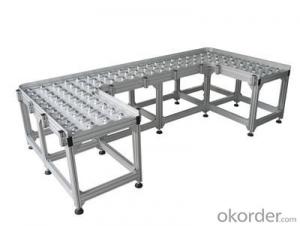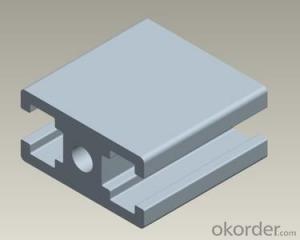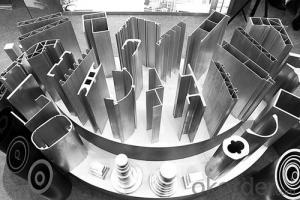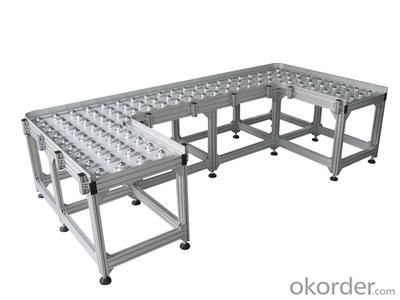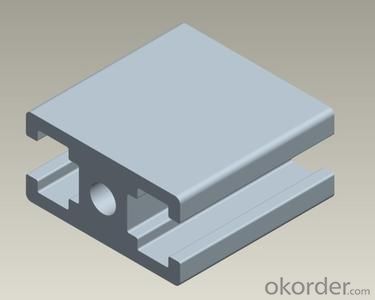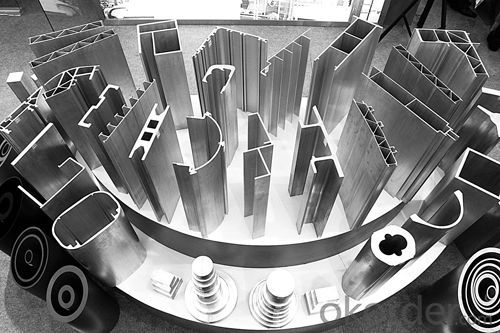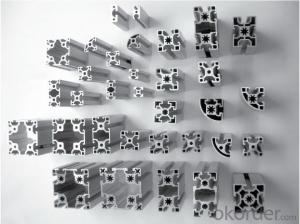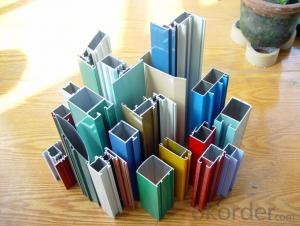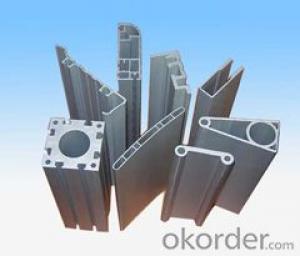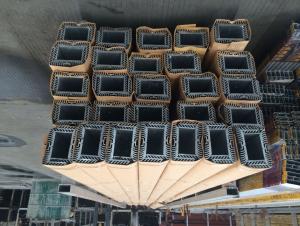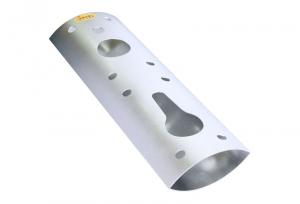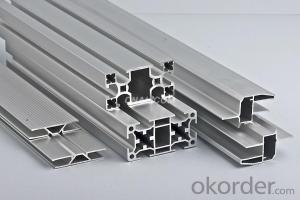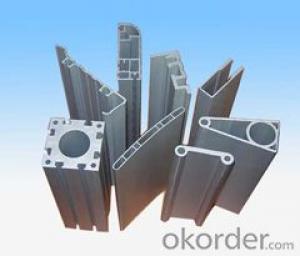Aluminum Extrusion Heat Sink Section Profiles
- Loading Port:
- China Main Port
- Payment Terms:
- TT OR LC
- Min Order Qty:
- -
- Supply Capability:
- -
OKorder Service Pledge
OKorder Financial Service
You Might Also Like
Aluminium is a relatively soft,durable, lightweight, ductile and malleablemetal with appearance ranging from silvery to dull gray,depending on the surface roughness. It is nonmagnetic and does not easilyignite. A fresh film of aluminium serves as a good reflector (approximately92%) of visible light and an excellent reflector (as much as98%) of medium and far infrared radiation. The yield strength of pure aluminium is 7–11 MPa,while aluminium alloys have yield strengths ranging from200 MPa to 600 MPa. Aluminium has about one-third the density and stiffnessof steel. It iseasily machined,cast, drawn and extruded.
Alu Profile:
Material | Alloy 6063,6061,6005or according to customer’s choice |
Temper | T3, T4, T5, T6 |
Surface | Anodize, electrophoresis, powder coating, PVDF coating, wood grain painting, matted, etc. |
Length | Coating 6.5 meters, Anodizing 6.5 meters, Mill finish 5 meters |
Application | Industrial, electrical equipment(TV set, air conditioner, refrigerator, computer), decoration,construction, transportation |
Custom Made | We can package following with customer's request. |
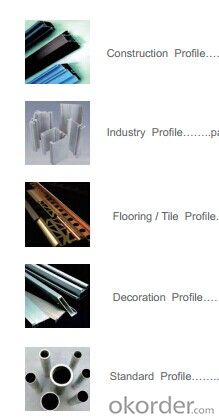
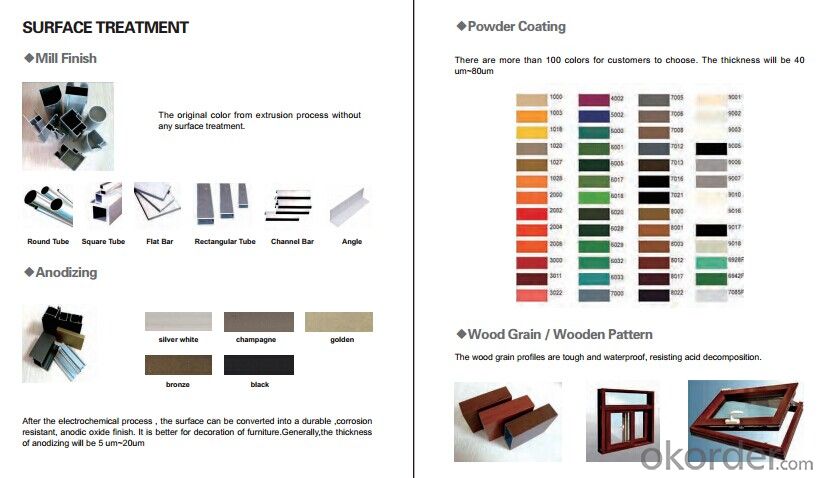
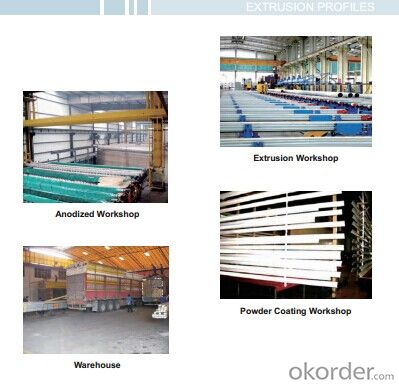
FAQ:
1. What is the form of payment?
Normally 30% TT, L/C at sight
2. Type of quotation?
FOB, CFR, CIF
3. Port of loading?
Guangzhou/Shenzhen port
4. Delivery time?
15-20 days after client’s deposit
- Q: This question asks for a method to determine whether the building materials include aluminum profiles.
- <p>To determine if your current building uses aluminum profiles, you can start by examining the visible structural components such as window frames, door frames, and support beams. Look for the characteristic silvery color and smooth finish of aluminum. You can also check the building's documentation or blueprints, if available, for material specifications. Consulting with the building's architect or engineer can provide definitive information. In some cases, a non-destructive testing method like ultrasonic testing might be used to identify materials without damaging the structure.</p>
- Q: Can aluminum profiles be used in solar reflector systems?
- Yes, aluminum profiles can be used in solar reflector systems. Aluminum is a commonly used material in solar reflector systems due to its high reflectivity and excellent corrosion resistance. Aluminum profiles can be easily customized and shaped into various forms to optimize the reflection of sunlight onto the solar panels. Additionally, aluminum profiles are lightweight and durable, making them suitable for outdoor applications. Overall, aluminum profiles are an effective and efficient choice for solar reflector systems.
- Q: Aluminum profile spraying process
- Pretreatment -- drying, removing moisture -- spraying -- Inspection -- baking -- Inspection -- finished.1, construction requirements, general powder spraying construction requirements:(1) in order to give full play to and extend the service life of the coating, the surface of the coating is strictly treated by surface pretreatment first(2) when spraying, the coating must be completely ground to increase the spraying efficiency of the powder coating(3) to be coated with larger surface defects, it should be coated with conductive putty to ensure the smooth and smooth coating(4) after the spraying, the objects and articles should be heated, cured and solidified. The technical indexes of the powder products should be adopted, but the curing temperature and time should be guaranteed so as to avoid the quality failures caused by solidification(5) check immediately after spraying, if found defects should be timely treatment, if after curing defects are found, the only local small range without affecting, the coated surface decoration, can use the same color powder and acetone diluted to repair, if the scope is large and affects the surface quality, use sandpaper after again. Or use the paint remover to remove the coating, re Suo powder.(6) the recovered powder must be screened and removed, and then mixed with the new powder at a certain proportion(7) the powder supply barrel, the powder spraying room and the recycling system should avoid contamination by other colors. Therefore, each color change must be cleaned
- Q: Are aluminum profiles suitable for decorative applications?
- Yes, aluminum profiles are suitable for decorative applications. Aluminum is a versatile material that offers several advantages in decorative applications. Firstly, aluminum profiles can be easily shaped and formed into various designs, allowing for endless possibilities in decorative applications. They can be extruded into different shapes, sizes, and patterns, giving designers the freedom to create unique and aesthetically pleasing decorative elements. Moreover, aluminum profiles offer excellent durability and corrosion resistance, making them suitable for both indoor and outdoor decorative applications. Aluminum is known for its ability to resist rust and weathering, ensuring that decorative elements made from aluminum profiles will maintain their appearance for a long time. Additionally, aluminum profiles can be finished in various ways to enhance their decorative appeal. They can be anodized or powder-coated to add color, texture, and protection to the surface. These finishing options allow for customization and the ability to match the profiles with the overall design scheme. Furthermore, aluminum profiles are lightweight yet strong, making them easy to install and handle during the decorative application process. This characteristic also makes them suitable for applications where weight is a consideration, such as in suspended or wall-mounted decorative elements. Lastly, aluminum is a sustainable and environmentally friendly material. It is 100% recyclable, and the production process of aluminum profiles requires considerably less energy compared to other materials. Choosing aluminum profiles for decorative applications aligns with sustainable design principles and contributes to reducing the environmental impact. In conclusion, aluminum profiles are highly suitable for decorative applications due to their versatility, durability, corrosion resistance, customization options, lightweight nature, and sustainability. Whether it's for interior or exterior decorative elements, aluminum profiles offer a wide range of possibilities to enhance the aesthetic appeal of any space.
- Q: What are the advantages of using aluminum profiles in the aviation industry?
- The aviation industry benefits from several advantages when utilizing aluminum profiles. To start with, the lightweight nature of aluminum is of utmost importance. In aviation, this characteristic plays a crucial role in reducing overall aircraft weight, ultimately leading to enhanced fuel efficiency. Manufacturers of aircraft can employ aluminum profiles to develop lighter structures without compromising on strength and durability. Furthermore, aluminum displays exceptional resistance to corrosion. This proves especially valuable in the aviation sector where aircraft are exposed to severe environmental conditions like high humidity, temperatures, and saltwater exposure. Aluminum profiles can withstand these conditions, effectively preventing corrosion and ensuring the long-lasting lifespan of the aircraft. In addition, aluminum profiles offer an impressive strength-to-weight ratio. This means they provide a sturdy and inflexible structure while remaining lightweight. This quality is essential for ensuring the structural integrity and safety of the aircraft. Aluminum profiles can endure the stresses and loads encountered during flight, thereby contributing to the overall safety of the aircraft. Moreover, aluminum is highly malleable, making it easy to shape and mold into intricate designs. This characteristic allows for greater design flexibility in aircraft manufacturing, enabling manufacturers to create aerodynamic and efficient structures. Aluminum profiles can be fabricated, welded, and joined with ease, providing convenience in manufacturing and assembly within the aviation industry. Lastly, aluminum is an incredibly recyclable material. With the growing emphasis on sustainability, utilizing aluminum profiles in aircraft construction helps reduce the carbon footprint. Aluminum can be recycled and reused multiple times without compromising its advantageous properties, making it an environmentally friendly choice. In conclusion, the utilization of aluminum profiles in the aviation industry offers numerous advantages, including lightweight construction, corrosion resistance, high strength-to-weight ratio, design flexibility, and recyclability. These properties position aluminum as an ideal material for aircraft manufacturing, contributing to improved fuel efficiency, safety, and sustainability.
- Q: What is a pouring type heat insulation aluminum profile?
- Pouring type thermal insulation aluminum profile is put into the liquid insulation curing Aluminum Alloy section casting trough and resection, Aluminum Alloy section casting trough Pro bridge connecting through the broken metal insulation material Aluminum Alloy insulation two combined composite material.
- Q: What are the different extrusion methods used for aluminum profiles?
- There are several different extrusion methods commonly used for aluminum profiles. These methods include: 1. Direct extrusion: This is the most common method used for aluminum extrusion. In this process, a heated billet of aluminum is forced through a die using a ram. The aluminum is pushed through the die, which shapes it into the desired form. Direct extrusion is a highly efficient and cost-effective method. 2. Indirect extrusion: In this method, the billet is held stationary while the die moves towards it. The die pushes the aluminum through the stationary billet, shaping it into the desired form. Indirect extrusion is often used for more complex shapes or when a higher level of precision is required. 3. Impact extrusion: This method involves forcing a billet of aluminum into a die cavity using a punch. The punch strikes the billet with high force, causing it to flow into the die and take its shape. Impact extrusion is commonly used for producing hollow parts or tubes. 4. Hydrostatic extrusion: This method involves using a fluid, usually oil or water, to pressurize the billet and force it through a die. The high pressure of the fluid allows for greater control and precision in shaping the aluminum. Hydrostatic extrusion is often used for producing high-quality, high-strength aluminum profiles. 5. Cold extrusion: In this method, the aluminum billet is extruded at room temperature. The lower temperature helps to achieve greater strength and better surface finish. Cold extrusion is commonly used for producing small, intricate aluminum profiles. Each of these extrusion methods has its own advantages and is suitable for different applications. The choice of method depends on factors such as the complexity of the profile, desired strength, surface finish requirements, and cost considerations.
- Q: How do you prevent galvanic corrosion in marine environments with aluminum profiles?
- One way to prevent galvanic corrosion in marine environments with aluminum profiles is by using sacrificial anodes made of a different, more active metal. These anodes, typically made of zinc or magnesium, are connected to the aluminum profiles and act as a sacrificial material that corrodes instead of the aluminum. This helps in protecting the aluminum profiles from galvanic corrosion. Additionally, proper insulation and coating of the aluminum profiles can also be effective in preventing direct contact with other metals and reducing the risk of galvanic corrosion.
- Q: What are the features of the poor aluminum profiles?
- Low precision, bad feel, and so on, some inferior shape.You'd better go to the manufacturer you trust.
- Q: How do aluminum profiles resist corrosion?
- Aluminum profiles resist corrosion due to the formation of a protective oxide layer on their surface. This oxide layer acts as a barrier, preventing any further reaction between the aluminum and the surrounding environment, thus inhibiting corrosion.
Send your message to us
Aluminum Extrusion Heat Sink Section Profiles
- Loading Port:
- China Main Port
- Payment Terms:
- TT OR LC
- Min Order Qty:
- -
- Supply Capability:
- -
OKorder Service Pledge
OKorder Financial Service
Similar products
Hot products
Hot Searches
Related keywords
